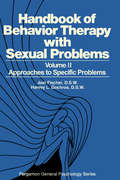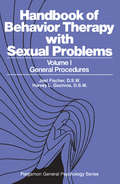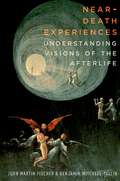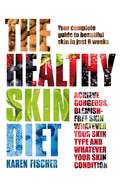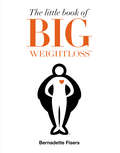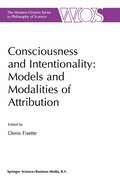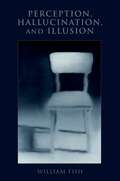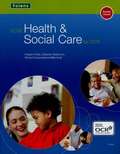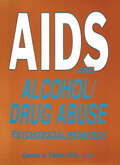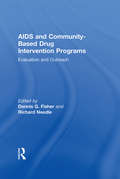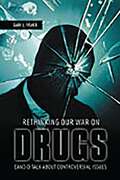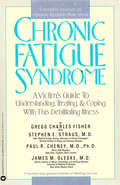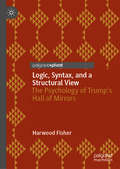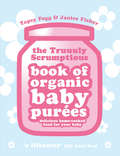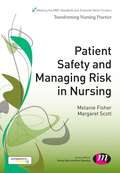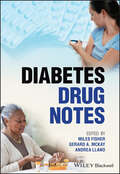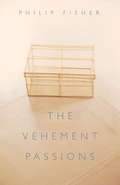- Table View
- List View
Approaches to Specific Problems: Handbook of Behavior Therapy with Sexual Problems
by Joel Fischer Harvey L. GochrosHandbook of Behavior Therapy with Sexual Problems, Volume II: Approaches to Specific Problems compiles case studies illustrating the use of techniques as they are applied to specific sexual problems. This publication is divided into two parts. Part I discusses approaches to the problems often encountered by men and women in heterosexual intercourse. For men, the two major areas included are problems with achieving or maintaining erections during sexual activities and problems associated with ejaculation. The problem areas covered for women are problems in orgasmic functioning and problems of painful or difficult intercourse. Part 2 elaborates sexual problems associated with undesired sexual object choices. The homosexual, fetishistic, cross-dressing, exhibitionistic, pedophiliac, sadomasochistic, voyeuristic and miscellaneous behaviors are also covered. This publication is a good reference for behaviorally-oriented clinicians and practitioners who are attempting to alleviate the suffering associated with their clients’ sexual problems.
General Procedures: Handbook of Behavior Therapy with Sexual Problems
by Joel Fischer Harvey L. GochrosGeneral Procedures deals with behavior-change procedures for diverse target behaviors. It aims to provide behavioral therapists with effective system of procedures for implementation with their clients who suffer from sexual problems. Its emphasis is on intervention rather the ""etiology"" of sexual problems and it describes all major techniques for dealing with sexual problems developed by behaviorists. This book is organized into two volumes. Volume I focuses on specific behavioral techniques developed or adapted for use with sexual problems. It also describes these techniques and indications for their use. Volume II covers the range of sexual problems to which behavior therapy procedures have been applied. Each volume is organized into two parts, the first part dealing with techniques and problems involved in heterosexual couple relationships, and the second part dealing with techniques and problems involved in undesired sexual object choices. This book will be of interest to persons dealing with studies on behavior therapy and those interested in understanding procedures and techniques for the treatment of sexual problems.
Near-Death Experiences: Understanding Visions of the Afterlife
by John Martin Fischer Benjamin Mitchell-YellinNear-death experiences offer a glimpse not only into the nature of death but also into the meaning of life. They are not only useful tools to aid in the human quest to understand death but are also deeply meaningful, transformative experiences for the people who have them. In a unique contribution to the growing and popular literature on the subject, philosophers John Martin Fischer and Benjamin Mitchell-Yellin examine prominent near-death experiences, such as those of Pam Reynolds, Eben Alexander and Colton Burpo. They combine their investigations with critiques of the narratives' analysis by those who take them to show that our minds are immaterial and heaven is for real. In contrast, the authors provide a blueprint for a science-based explanation. Focusing on the question of whether near-death experiences provide evidence that consciousness is separable from our brains and bodies, Fischer and Mitchell-Yellin give a naturalistic account of the profound meaning and transformative effects that these experiences engender in many. This book takes the reality of near-death experiences seriously. But it also shows that understanding them through the tools of science is completely compatible with acknowledging their profound meaning.
Near-Death Experiences: Understanding Visions of the Afterlife
by John Martin Fischer Benjamin Mitchell-YellinNear-death experiences offer a glimpse not only into the nature of death but also into the meaning of life. They are not only useful tools to aid in the human quest to understand death but are also deeply meaningful, transformative experiences for the people who have them. In a unique contribution to the growing and popular literature on the subject, philosophers John Martin Fischer and Benjamin Mitchell-Yellin examine prominent near-death experiences, such as those of Pam Reynolds, Eben Alexander and Colton Burpo. They combine their investigations with critiques of the narratives' analysis by those who take them to show that our minds are immaterial and heaven is for real. In contrast, the authors provide a blueprint for a science-based explanation. Focusing on the question of whether near-death experiences provide evidence that consciousness is separable from our brains and bodies, Fischer and Mitchell-Yellin give a naturalistic account of the profound meaning and transformative effects that these experiences engender in many. This book takes the reality of near-death experiences seriously. But it also shows that understanding them through the tools of science is completely compatible with acknowledging their profound meaning.
The Healthy Skin Diet: Your complete guide to beautiful skin in just 8 weeks!
by Karen FischerYour skin is one of the first things people notice when they meet you. It's the face you present to the world. By ensuring that your skin is in the best possible condition, you can not only improve your overall health, but also your confidence and happiness. Whether you are suffering from acne, cellulite, dandruff or psoriasis, Karen Fischer's natural approach and vast experience treating private clients will help you treat the problem and get the beautiful skin you always wanted. In this fantastic book you will discover: - The 8 essential guidelines for healthy skin, including establishing a good skin-care routine, exercise and eating moisturising foods - Specialized programmes for a wide range of skin conditions, including advice specifically for babies and children - The 8-week healthy skin diet, including delicious, nutritious recipes and ideas to try
Food You Want: For the Life You Crave
by Nealy FischerA "wellness visionary who serves up super-food!" (Mark Hyman, MD) shares her tips, secrets, and +100 gluten-free recipes for living a healthy, flexible life--in the kitchen and out.Whether you're a parent feeding family of 6 or cooking for 1 or 2, you're probably busy--really busy--juggling all of life's obligations. And you probably just want to sit down for a meal of food you truly want--craveable, healthy food that makes you feel as good as it tastes. With more than 100 clean, fresh, gluten-free recipes, Food You Want helps you create healthy, energizing dishes, all while saving time and banishing meal prep stress. With Nealy's Flexible Flips, you can mix, match, and substitute ingredients. Some Flips health-ify recipes (pizza quiche that tastes just like a real slice of pizza); other Flips transform taste, showing you that healthy can always equal delicious. Have a Flop? No worries--there are Flips for those too. With Nealy's flexible, adaptable system you'll have a simpler recipe for success, both in and out of the kitchen. You can make each meal--and each day--less harried and more enjoyable.
Food You Want: For the Life You Crave
by Nealy FischerA "wellness visionary who serves up super-food!" (Mark Hyman, MD) shares her tips, secrets, and +100 gluten-free recipes for living a healthy, flexible life--in the kitchen and out.Whether you're a parent feeding family of 6 or cooking for 1 or 2, you're probably busy--really busy--juggling all of life's obligations. And you probably just want to sit down for a meal of food you truly want--craveable, healthy food that makes you feel as good as it tastes. With more than 100 clean, fresh, gluten-free recipes, Food You Want helps you create healthy, energizing dishes, all while saving time and banishing meal prep stress. With Nealy's Flexible Flips, you can mix, match, and substitute ingredients. Some Flips health-ify recipes (pizza quiche that tastes just like a real slice of pizza); other Flips transform taste, showing you that healthy can always equal delicious. Have a Flop? No worries--there are Flips for those too. With Nealy's flexible, adaptable system you'll have a simpler recipe for success, both in and out of the kitchen. You can make each meal--and each day--less harried and more enjoyable.
The Little Book of Big Weightloss
by Bernadette FisersThe Little Book of Big Weightloss is for anyone who has tried and failed to lose weight long term - anyone who has grown tired of all the confusing, conflicting advice and complicated diet plans on offer. Based on a simple set of 31 food and lifestyle 'rules', this inspiring book is packed with invaluable tips and strategies and provides a fresh, 'can do' approach to dieting and sustainable health benefits.Successful hair and makeup artist Bernadette Fisers had struggled with her weight for years. She'd tried and failed at many diets over the years but things came to a head when she was forced to face some harsh truths: her weight had ballooned to almost 130 kilos and she had a BMI reading of 42. Pre-diabetic and diagnosed as morbidly obese with a fatty liver and high blood pressure, Bern decided that now was the time to ditch the faddy diets and take matters into her own hands to turn her life around. So she turned to those she knew well, the glamorous models she worked with, finding out about their healthy eating habits and their tips on staying trim. She also began researching medical reports and health and nutrition papers, until finally - by trial, error and a lot of experimentation - she created a healthy lifestyle plan that was quick to read, easy to follow and, most importantly, would work long term. Following her new 'rules', Bern went on to lose more than 30 kilos in just 30 weeks and she is now on a mission to help others to achieve their goals.
Consciousness and Intentionality: Models and Modalities of Attribution (The Western Ontario Series in Philosophy of Science #62)
by D. FisettePhilosophy of mind has been one of the most active fields in philosophy for the past three decades. One of the most significant factors in the development of this discipline has been the emergence of cognitive science and the interest philosophers have taken in the empirical study of mind. Another equally important factor has been the "naturalistic tum" brought about by W. V. Quine. His proposal that normative epistemology be replaced by empirical psychology marked a radical departure from the Fregean "anti psychologism" and "apriorism" that had characterized much of the analytic tradition in philosophy. But while Quine's program of naturalization called the attention of philosophers to empirical psychology, his conception of psychology was inspired by an austere behaviorism which shunned the mentalism of intentional psychology in the Brentanian and phenomenological tradition. Thus, while agreeing with Brentano that the "intentional idiom" could not be reduced to that of the natural sciences, Quine argued that it is of a piece with the indeterminacy of translation. Most contributors of this col lection share the cognitivist stance and believe that the mind needs to be explained rather than eliminated. Three main questions are actually confronting current philosophers of mind, each addressed by one or another of the contributors to the present collection.
Franz Brentano’s Philosophy After One Hundred Years: From History of Philosophy to Reism (Primary Sources in Phenomenology)
by Denis Fisette Guillaume Fréchette Hynek JanoušekThis volume brings together contributions that explore the philosophy of Franz Brentano. It looks at his work both critically and in the context of contemporary philosophy. For instance, Brentano influenced the phenomenology of Edmund Husserl, the theory of objects of Alexius Meinong, the early development of the Gestalt theory, the philosophy of language of Anton Marty, the works of Carl Stumpf in the psychology of tone, and many others. Readers will also learn the contributions of Brentano's work to much debated contemporary issues in philosophy of mind, ontology, and the theory of emotions. The first section deals with Brentano’s conception of the history of philosophy. The next approaches his conception of empirical psychology from an empirical standpoint and in relation with competing views on psychology from the period. The third section discusses Brentano’s later programme of a descriptive psychology or “descriptive phenomenology” and some of his most innovative developments, for instance in the theory of emotions. The final section examines metaphysical issues and applications of his mereology. His reism takes here an important place. The intended readership of this book comprises phenomenologists, analytic philosophers, philosophers of mind and value, as well as metaphysicians. It will appeal to both graduate and undergraduate students, professors, and researchers in philosophy and psychology.
Perception, Hallucination, and Illusion (Philosophy of Mind)
by William FishThe idea of a disjunctive theory of visual experiences first found expression in J.M. Hinton's pioneering 1973 book Experiences. In the first monograph in this exciting area since then, William Fish develops a comprehensive disjunctive theory, incorporating detailed accounts of the three core kinds of visual experience--perception, hallucination, and illusion--and an explanation of how perception and hallucination could be indiscriminable from one another without having anything in common. In the veridical case, Fish contends that the perception of a particular state of affairs involves the subject's being acquainted with that state of affairs, and that it is the subject's standing in this acquaintance relation that makes the experience possess a phenomenal character. Fish argues that when we hallucinate, we are having an experience that, while lacking phenomenal character, is mistakenly supposed by the subject to possess it. Fish then shows how this approach to visual experience is compatible with empirical research into the workings of the brain and concludes by extending this treatment to cover the many different types of illusion that we can be subject to.
Perception, Hallucination, and Illusion (Philosophy of Mind)
by William FishThe idea of a disjunctive theory of visual experiences first found expression in J.M. Hinton's pioneering 1973 book Experiences. In the first monograph in this exciting area since then, William Fish develops a comprehensive disjunctive theory, incorporating detailed accounts of the three core kinds of visual experience--perception, hallucination, and illusion--and an explanation of how perception and hallucination could be indiscriminable from one another without having anything in common. In the veridical case, Fish contends that the perception of a particular state of affairs involves the subject's being acquainted with that state of affairs, and that it is the subject's standing in this acquaintance relation that makes the experience possess a phenomenal character. Fish argues that when we hallucinate, we are having an experience that, while lacking phenomenal character, is mistakenly supposed by the subject to possess it. Fish then shows how this approach to visual experience is compatible with empirical research into the workings of the brain and concludes by extending this treatment to cover the many different types of illusion that we can be subject to.
GCSE Health And Social Care Double Award (PDF)
by Angela Fisher Stephen SeamonsRetaining all the great features that made Folens GCSE Health and Social Care an essential text, this book has been written to provide an exact match to the new OCR specification. Chapters clearly lay out learning and assessment objectives for the new specification with a chapter to cover the new OCR Unit on Safeguarding and Protecting Individuals.
AIDS and Alcohol/Drug Abuse: Psychosocial Research
by Dennis FisherAIDS is the number one health issue facing the nation today. The way in which AIDS relates to substance abuse is explored by drug abuse researchers in this timely volume. A major focus of AIDS and Alcohol/Drug Abuse is on the problems of conducting AIDS research on racial minorities in this country. Bringing together experts in the field, this volume examines the specific obstacles and challenges researchers have faced in assessing and addressing the needs of underserved populations and maps routes and procedures that can improve both research and available health care services.This unique volume also focuses on aspects of HIV infection that have received little attention elsewhere. It includes the first information published in the open literature about intravenous drug use in Alaska. Another chapter highlights some little-known facts that relate substance abuse to HIV infection in the American Indian/Alaskan Native population, among whom--it has been predicted--a devastating epidemic of HIV infection is likely. Problems with prevention, research, and treatment of individuals who are both intravenous drug users and who are infected with HIV are explored. Other chapters look at the transmission of HIV infection--by gay men who are alcoholics and by intravenous drug users. AIDS and Alcohol/Drug Abuse ends with hopeful chapter for AIDS prevention. Readers interested in the relationship of intravenous drug use and HIV infection, particularly among racial and ethnic minorities, will find this to be a practical, readable book. In particular, substance abuse counselors and researchers, and anyone involved in the AIDS prevention movement will find a valuable wealth of information.
AIDS and Alcohol/Drug Abuse: Psychosocial Research
by Dennis FisherAIDS is the number one health issue facing the nation today. The way in which AIDS relates to substance abuse is explored by drug abuse researchers in this timely volume. A major focus of AIDS and Alcohol/Drug Abuse is on the problems of conducting AIDS research on racial minorities in this country. Bringing together experts in the field, this volume examines the specific obstacles and challenges researchers have faced in assessing and addressing the needs of underserved populations and maps routes and procedures that can improve both research and available health care services.This unique volume also focuses on aspects of HIV infection that have received little attention elsewhere. It includes the first information published in the open literature about intravenous drug use in Alaska. Another chapter highlights some little-known facts that relate substance abuse to HIV infection in the American Indian/Alaskan Native population, among whom--it has been predicted--a devastating epidemic of HIV infection is likely. Problems with prevention, research, and treatment of individuals who are both intravenous drug users and who are infected with HIV are explored. Other chapters look at the transmission of HIV infection--by gay men who are alcoholics and by intravenous drug users. AIDS and Alcohol/Drug Abuse ends with hopeful chapter for AIDS prevention. Readers interested in the relationship of intravenous drug use and HIV infection, particularly among racial and ethnic minorities, will find this to be a practical, readable book. In particular, substance abuse counselors and researchers, and anyone involved in the AIDS prevention movement will find a valuable wealth of information.
AIDS and Community-Based Drug Intervention Programs: Evaluation and Outreach
by Dennis Fisher Richard NeedleDelve into the uncharted territory of the “hidden” drug addict--users who are not in treatment, not incarcerated, and not officially accessible for research purposes through traditional means. AIDS and Community-Based Drug Intervention Programs describes short-term interventions used to reduce the odds that these drug users will get infected by the Human Immunodeficiency Virus (HIV). The book explains new methods that are being developed, such as targeted sampling, social network analysis, geomapping, and other amalgams of both quantitative and qualitative approaches, that need to be forged to overcome the challenges of the war against AIDS. The research described in this important book was conducted under the Cooperative Agreement for AIDS Community-Based Outreach/Intervention Research funding mechanism of the National Institute on Drug Abuse (NIDA). Chapters include research on several ethnic groups, including Alaska natives, Puerto Ricans, and Navaho teens. AIDS and Community-Based Drug Treatment Programs, written by experts in the field, is a broad-based treatment of the subject by those who are actually doing the work in the trenches. Authors cover topics such as: the use of goal-oriented counseling and peer support to reduce HIV/AIDS risk quantitative and qualitative methods to assess behavioral change among injection drug users (IDUs) the importance of sampling from hidden populations in research a public health model for reducing AIDS-related risk behavior among IDUs and their sexual partners characteristics of female sexual partners of IDUs strategies used to implement random sampling strategies in the recruitment of out-of-treatment crack and IDUs ethnographic analysis of intravenous drug use analysis of contact tracing strategies employed to combat the AIDS epidemic the use of pile sorts to enhance other tools used by drug prevention programsAIDS and Community-Based Drug Intervention Programs is full of current research and useful information for professionals interested in learning about strategies for conducting HIV/AIDS research among hard-to-reach populations. Substance abuse researchers, treatment professionals, and people involved in AIDS prevention programs, state and county health departments, and criminal justice systems will find much relevant and important information to use in their daily work.
AIDS and Community-Based Drug Intervention Programs: Evaluation and Outreach
by Dennis Fisher Richard NeedleDelve into the uncharted territory of the “hidden” drug addict--users who are not in treatment, not incarcerated, and not officially accessible for research purposes through traditional means. AIDS and Community-Based Drug Intervention Programs describes short-term interventions used to reduce the odds that these drug users will get infected by the Human Immunodeficiency Virus (HIV). The book explains new methods that are being developed, such as targeted sampling, social network analysis, geomapping, and other amalgams of both quantitative and qualitative approaches, that need to be forged to overcome the challenges of the war against AIDS. The research described in this important book was conducted under the Cooperative Agreement for AIDS Community-Based Outreach/Intervention Research funding mechanism of the National Institute on Drug Abuse (NIDA). Chapters include research on several ethnic groups, including Alaska natives, Puerto Ricans, and Navaho teens. AIDS and Community-Based Drug Treatment Programs, written by experts in the field, is a broad-based treatment of the subject by those who are actually doing the work in the trenches. Authors cover topics such as: the use of goal-oriented counseling and peer support to reduce HIV/AIDS risk quantitative and qualitative methods to assess behavioral change among injection drug users (IDUs) the importance of sampling from hidden populations in research a public health model for reducing AIDS-related risk behavior among IDUs and their sexual partners characteristics of female sexual partners of IDUs strategies used to implement random sampling strategies in the recruitment of out-of-treatment crack and IDUs ethnographic analysis of intravenous drug use analysis of contact tracing strategies employed to combat the AIDS epidemic the use of pile sorts to enhance other tools used by drug prevention programsAIDS and Community-Based Drug Intervention Programs is full of current research and useful information for professionals interested in learning about strategies for conducting HIV/AIDS research among hard-to-reach populations. Substance abuse researchers, treatment professionals, and people involved in AIDS prevention programs, state and county health departments, and criminal justice systems will find much relevant and important information to use in their daily work.
Rethinking Our War on Drugs: Candid Talk about Controversial Issues
by Gary L. FisherThe National Drug Control Policy has failed its two major functions (supply reduction and demand reduction) due to faulty assumptions regarding nearly every aspect of the alcohol and drug fields, charges author Fisher. Yet in spite of overwhelming evidence of this failure policy makers have strongly resisted discussing major changes to the assumptions that underly current policy, because of political pressure, bias and philosophical intransigence, he adds. Fisher discusses controversial topics and defends uncommon approaches in chapters focused on subjects including legalization, harm reduction, the futility of supply reduction, the problem of underage drinking and effectiveness of treatment and prevention. He proposes a new national policy for drug control, including elimination of the war metaphor, inclusion of alcohol in the mandate, conceptualization of addiction as a public health problem, utilization of harm reduction principles to guide policy and discontinuation of approaches that isolate drug and alcohol problems from their connection to broader social issues such as poverty.In this work, the premises of the current National Drug Control Strategy are challenged, and both Democratic and Republican administrations across the last 10 years are critically examined. Statements of the Director of the Office of National Drug Control Strategy are critiqued. Major points include that there is no evidence the NDCS has achieved any of its goals, that harm reduction should be its guiding principle, and supply reduction should not be part of the national strategy.
Chronic Fatigue Syndrome: A Comprehensive Guide to Symptoms, Treatments, and Solving the Practical Problems of CFS
by Gregg Charles Fisher Paul R. Cheney Nelson M. Gantz David C. Klonoff James M. OleskeIn this enlightening and compassionate guide, one of the foremost specialists in Chronic Fatigue Syndrome--himself a ten-year survivor of the disease--helps victims and their loved ones regain control of their lives. This updated edition includes new information about current medical treatments, related disorders, and strategies for living with the CFS.
Logic, Syntax, and a Structural View: The Psychology of Trump's Hall of Mirrors
by Harwood FisherThis book presents a new structural approach to the psychology of the person, inspired by Kenneth Colby’s computer-generated simulation, PARRY. The simulation was of a paranoid psychological state, represented in forms of the person's logic and syntax, as these would be evidenced in personal communication. Harwood Fisher uses a Structural View to highlight similarities in the logical form of the linguistic representations of Donald Trump, his avid followers (“Trumpers”), and the paranoid—referred to as “The Trio.” He demonstrates how the Structural View forms a series of logical and schematic patterns, similar to the way that content analysis can bring forth associations meanings, and concepts held in the text. Such comparisons, Fisher argues, can be used to shed light on contingencies for presenting, representing, and judging truth. Specifically, Fisher posits that the major syntactic and logical patterns that were used to produce the computer-generated “paranoid” responses in Colby’s project can be used to analyze Donald Trump’s rhetoric and his followers’ reactions to it. Ultimately, Fisher offers a new kind of structural approach for the philosophy of psychology. This novel work will appeal to students and scholars of social and cognitive psychology, psychology of personality, psychiatric classification, psycholinguistics, rhetoric, and computer science.
Truuuly Scrumptious Book of Organic Baby Purees: Delicious home-cooked food for your baby
by Janice Fisher Topsy FoggLike all parents, Topsy Fogg and Janice Fisher wanted to give their babies the best possible start in life. And like Jamie Oliver before them, they realised that the best start begins with what they give their children to eat. Topsy and Janice are the founders of the award-winning organic baby food brand, Truuuly Scrumptious, a delicious range of homestyle, top-quality food for babies aged six months through to toddlers. In this beautifully illustrated book, Topsy and Janice share their scrumptious recipes to ensure that parents give their babies all the essential nutrients that are vital for healthy growth and development. They also explain how to wean babies; why going organic is best; and how to source, prepare and cook the best-quality ingredients.From vitamin-packed first stage purées such as butternut squash and broccoli through more substantial meals such as lamb and apricot casserole to finger foods such as carrot, courgette and cheese muffins, these recipes are so tasty parents will be making extra portions for themselves too!
Patient Safety and Managing Risk in Nursing (PDF)
by Melanie FisherPatient safety is a predominant feature of quality healthcare and something that every patient has the right to expect. Nurses must consider the safety of the patient as paramount in every aspect of their role; and it is now an increasingly important topic in pre-registration nursing programmes. This book aims to provide nursing students and new nurses with a greater understanding of how to manage patient safety and risk in their own practice. The book focuses on the essentials that students and nurses need to know, and therefore provides a clear pathway through what can sometimes seem an overwhelmingly complex mass of rules, procedures and possible options.
Diabetes Drug Notes
by Miles Fisher Gerard A. McKay Andrea LlanoDIABETES DRUG NOTES Diabetes is becoming more common in both older and younger generations and in keeping with this escalation in cases, there are an ever increasing number of drugs and drug classes that are suitable to treat hyperglycaemia. In a unique blend of diabetes practice, clinical pharmacology, and cardiovascular medicine, Diabetes Drug Notes describes the principles of clinical pharmacology with regards to diabetes prescribing. Each drug class for the treatment of diabetes is covered in detail, along with the effect on the cardiovascular and renal systems caused by each drug. Building upon the success of their “Drug Notes” series for Practical Diabetes and their “Drugs for Diabetes” series in the British Journal of Cardiology, the team of experts focuses on the glycaemic management of type 1 and type 2 diabetes, with other effects of antidiabetic drugs covered as well. Diabetes Drug Notes also includes: Comprehensive and up-to-date coverage of the drugs for the glycaemic management of patients with type 1 or type 2 diabetes Expert reflection on prescribing considerations for special groups, as well as common pitfalls in prescribing Detailed case histories to illustrate relevant information Summaries of recent guidelines related to diabetic intervention Diabetes Drug Notes is a user-friendly guide for a general diabetes medical, nursing, and pharmacology readership, as well as those who support them.
The Vehement Passions
by Philip FisherBreaking off the ordinary flow of experience, the passions create a state of exception. In their suddenness and intensity, they map a personal world, fix and qualify our attention, and impel our actions. Outraged anger drives us to write laws that will later be enforced by impersonal justice. Intense grief at the death of someone in our life discloses the contours of that life to us. Wonder spurs scientific inquiry. The strong current of Western thought that idealizes a dispassionate world has ostracized the passions as quaint, even dangerous. Intense states have come to be seen as symptoms of pathology. A fondness for irony along with our civic ideal of tolerance lead us to prefer the diluted emotional life of feelings and moods. Demonstrating enormous intellectual originality and generosity, Philip Fisher meditates on whether this victory is permanent-and how it might diminish us. From Aristotle to Hume to contemporary biology, Fisher finds evidence that the passions have defined a core of human nature no less important than reason or desire. Traversing the Iliad, King Lear, Moby Dick, and other great works, he discerns the properties of the high-spirited states we call the passions. Are vehement states compatible with a culture that values private, selectively shared experiences? How do passions differ from emotions? Does anger have an opposite? Do the passions give scale, shape, and significance to our experience of time? Is a person incapable of anger more dangerous than someone who is irascible? In reintroducing us to our own vehemence, Fisher reminds us that it is only through our strongest passions that we feel the contours of injustice, mortality, loss, and knowledge. It is only through our personal worlds that we can know the world.
The Vehement Passions
by Philip FisherBreaking off the ordinary flow of experience, the passions create a state of exception. In their suddenness and intensity, they map a personal world, fix and qualify our attention, and impel our actions. Outraged anger drives us to write laws that will later be enforced by impersonal justice. Intense grief at the death of someone in our life discloses the contours of that life to us. Wonder spurs scientific inquiry. The strong current of Western thought that idealizes a dispassionate world has ostracized the passions as quaint, even dangerous. Intense states have come to be seen as symptoms of pathology. A fondness for irony along with our civic ideal of tolerance lead us to prefer the diluted emotional life of feelings and moods. Demonstrating enormous intellectual originality and generosity, Philip Fisher meditates on whether this victory is permanent-and how it might diminish us. From Aristotle to Hume to contemporary biology, Fisher finds evidence that the passions have defined a core of human nature no less important than reason or desire. Traversing the Iliad, King Lear, Moby Dick, and other great works, he discerns the properties of the high-spirited states we call the passions. Are vehement states compatible with a culture that values private, selectively shared experiences? How do passions differ from emotions? Does anger have an opposite? Do the passions give scale, shape, and significance to our experience of time? Is a person incapable of anger more dangerous than someone who is irascible? In reintroducing us to our own vehemence, Fisher reminds us that it is only through our strongest passions that we feel the contours of injustice, mortality, loss, and knowledge. It is only through our personal worlds that we can know the world.
